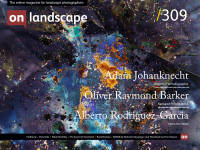Chris Dale chooses one of his favourite images

Chris Dale
Chris Dale is a photographer based in Nottingham and passionate about shooting locally, even when there are no big landmarks or epic vistas, revisiting the same area over a long period and exploring different ways to represent the landscape. The images concentrate mostly on intimate woodland scenes and abstract interpretations, trying to capture the essence of the place at that time.
When I was asked to write an End Frame article, it took me a while to consider which photo I would choose. There are many photographers whose work I greatly admire, however I’m not often one to pick individual favourites. In a similar way as I appreciate the craft my favourite bands put into producing a cohesive album rather than listening to a single song, I love looking at books, projects or portfolios more often than picking out just one image.
However, a couple of photos came to mind, and I kept coming back to this one in particular. I first encountered this image on my Twitter feed in early 2022. Having never seen Renate Wasinger’s work before, it immediately stopped me from scrolling by. Renate’s biography includes a quote attributed to Henri Cartier-Bresson: "A good photo is one that you look at for more than a second." This rings especially true in the days of social media and is exactly what caught me here.
The silhouette of a lone tree on a hilltop is something countless photographers have sought out. With a subject like this, it’s hard to make a bad composition but what really stands out to me is the character that exudes from the imperfections in this piece. I’m not privy to the techniques Renate uses on the more abstract frames like this from her gallery. It has the feeling of a lensbaby, or Susan Burnstines homemade cameras, with very little sharpness outside the slightly off-centre focal point. This progresses to a fairly extreme blurring of the horizon by the edge of the frame, where it merges into the vignette. The entire frame is also broken into almost two distinct shades of grey, with reasonably low contrast from a flat, overcast sky alongside a crushed and lifted black point which retains almost no detail, breaking the traditional rules of black and white photography where many people assume high contrast is a must.

